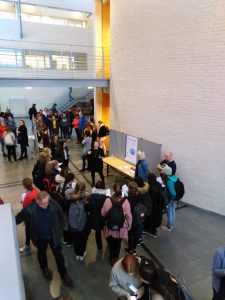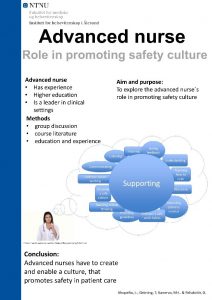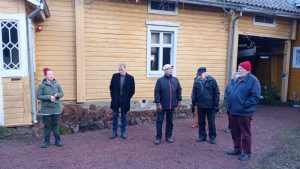Miten museoista tehdään paikkoja, joissa ikämiehet vierailevat useammin? CoMe Stronger -hanke vastaa tähän kysymykseen kääntämällä roolit toisinpäin: ikämiehet eivät ole…
Tekijät | Authors

Safety culture is in core of medication safety
In Finland, every 10th patient experiences adverse event, and approximately half of the events are related to medication care. Half of the medication errors could have been prevented often very simple methods. Therefore, we need to create environment to support initiatives in developing and ensuring medication safety in different nursing settings.
Safety culture as a premise of high quality health care
Medication safety is important because medication errors (MEs) are the most common type of medical error and are associated with increase of health care expenses (Halligan & Zecevic 2011). Given the high number of medication errors, many practices have emerged in the past decade to increase the safety of the medication administration process (e.g. Choo 2010). The work has not been a waste, for example recent review by Keers. et al. (2014) indicated that the interventions has improved medication administration safety. However, in ensuring and enhancing patient safety, the safety culture need to be seen as a premise.
The World Health Organization (WHO) defines patient safety as “the prevention of errors and adverse effects to patients associated with health care” and “to do no harm to patients” Achieving a culture of safety requires an understanding of the values, attitudes, beliefs and norms important to health care organization, what attitudes and behaviors are appropriate and expected for patient safety from the nursing staff and nurse leaders (see Halligan & Zecevic 2011). In Finland, to enhance patient safety, updated patient safety strategy was published in 2017 (Finnish Ministry of Social Affairs and Health 2017).

Intensive course in Norway
Medico (Nordic Medication Educators Collaboration) organized an intensive course about medication safety for BS and MS students in Nursing. The course was held at NTNU (Norwegian University of Science and Technology) in Ålesund, Norway from 4th to 8th of March 2019. One of the themes was safety culture. The aim was to develop bachelor students understanding about patient safety culture in medication care and enhance their self-confidence. For master students the main focus of the course students was on advanced nurses` role in creating the safety culture. There were participants from all the Nordic countries and Estonia. The education varies between the countries, and the teaching methods. However, the aim of the education and the actual challenges in medication safety are similar.
During different workshops we noticed differences between medication procedures in different countries. Medication safety has been in interests of all the countries, however, the phase of development varies among the countries. Despite the differences in medication procedures, it became clear that all the students were dedicated to improving medication safety and quality of care.
The workshops helped us to understand how much collaboration and education is needed in creation of safety culture.
The safety culture is the basis for all the other aspect of medication safety, every nurse need to commit to it and the nurse leaders and advanced nurses` role is to create it.
In successful safety culture there is on the other hand respect for the authorities and the guidelines and on the other the hand open work environment, where personnel can make questions and mistakes without judgement. Advanced nurse´s key role is to create a safe environment in all the areas of medication safety.
Advanced nurses´ role became clearer as the course proceeded (figure 1). It was very interesting and eye-opening. For example, they need to make evidence-based guidelines and how to handle the adverse events. It is important for the nurses and nursing students to be able to trust the advanced nurses and that there is confidential work environment.

Lessions learned
During the course we had a change to talk with BC and MS students from different countries. The discussion were mainly about the whole nursing culture in hospitals and other facilities. Discussions focused on a nurses role, education and which kind of responsibilities nurses have.
In every Nordic country nurses role is pretty similar. However, there was variation in education. Iceland has 4 years of education (240 ECTS), Sweden has 3 (180 ECTS). In Finland you have to have a specific licence to give medication in every hospital, but in Sweden that’s included to the education. These are just examples.
We discussed a lot about medication safety also, since that was the topic of the course. We noticed that a lot of the medication safety problems that we had were also quite similar in every country: patients identification, hierarchy issues, how to teach and learn. Medication safety was experienced one of the most important tasks that a nurse can have, so that was put on a lot of effort.
As master students we discussed about that how nice it was to see how enthusiastic, professional and smart all the bachelor students were. Definitely future nurses will improve safety culture.
References
Choo J. (2010). Nurses’ role in medication safety. Journal of Nursing Management 18, 853–861.
European Medicine Agency EMA 2013. Workshops on medication errors. https://www.youtube.com/watch?v=mAX02P6LhD0&list=PL7K5dNgKnawZvwLR8UNZceXqpEqKbPpKL
Halligan M & Zecevic A (2011) Safety culture in healthcare: a review of concepts, dimensions, measures and progress BMJ quality & safety 20(4), 338-343.
Härkänen M. (2014) Medication-related Adverse Outcomes and Contributing Factors among Hospital Patients. Academic dissertation. University of Eastern Finland.
Keers. et al. (2014). Impact of Interventions Designed to Reduce Medication Administration Errors in Hospitals: A Systematic Review. Drug Safety 37, 317-332.
Ministry of Social Affairs and Health 2017. Government resolution . Patient and client safety strategy 2017–2021. Publications of the Ministry of Social Affairs and Health 2017:9. Available at https://stm.fi/potilasturvallisuus
Sulosaari & Hahtela (toim.) (2013). Sairaanhoitaja & lääkehoito. Hoitotyön vuosikirja 2013. Sairaanhoitalaliitto, Fioca Oy
World Health Organization, G. (2009) Conceptual framework for the international classification for patient safety. Available at https://www.who.int/patientsafety/taxonomy/icps_full_report.pdf
Willman ym. 2008. A report on patient safety in Europe: medication errors and hospital-acquired infection. Journal of Research in Nursing 13(5), 451–454.
Zsifkovits, J. (2015). Costs of unsafe care and cost-effectiveness of patient safety programmes. EU patient safety and quality of care expert group. Brussels, September 28th 2015.








